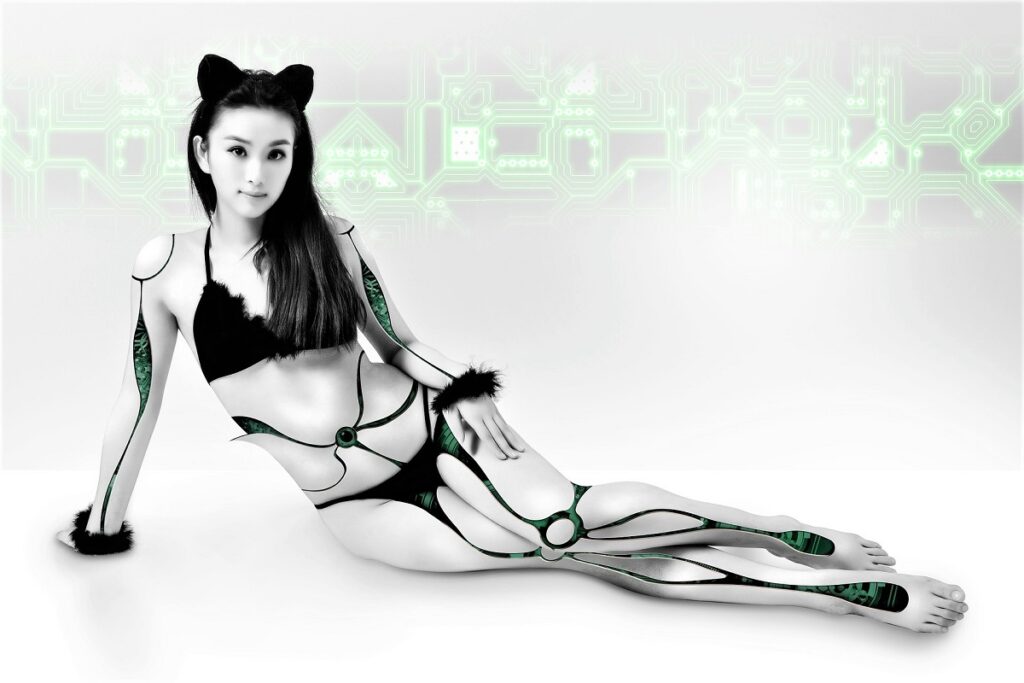Depending on who you ask, Harmony may well be the perfect girlfriend. She can maintain a conversation, tell jokes, and quote lines from Thomas Pynchon.
She can talk to you about music, movies, and books. She remembers your birthday, knows what you like to eat, and will recite your favorite poem if you so wish.
She will also have sex with you any time you want, any which way you want.
Harmony is all that and something else, too. She is the product of 20 years of making sex dolls, and five years of robot research and development.

(Screen Grab: San Diego Union-Tribune/Youtube)
Sex Robots as Substitute Partners
Realbotix founder Matt McMullen says his customers wanted something as lifelike as possible. With the help of other “robot heads,” the 49-year-old CEO created just that, building silicone and steel dolls so lifelike you half-expect them to speak. That became his brand’s calling card and subsequent objective.
From there, the next step seemed inevitable. McMullen and his team would give the dolls personality, bring them to life, make them speak – and much more. Harmony is the first of her kind out of the Realbotix laboratory.
The urge to create an ideal being to serve – or be worshiped by – its owner has preoccupied mankind since ancient times.
Pliny the Elder describes how men were smitten by the beautiful, undraped statue of Aphrodite at Knidos. The Roman philosopher says the statue was so attractive men snuck into the shrine at night to be with the stone-cold beauty. The stains discovered on Aphrodite’s marble thighs in the morning betrayed the rapaciousness of their yearning.

But other than their basis in history, there is nothing ancient about Harmony and the modern sex tech industry. What began ten years ago as a handful of companies building geeky sex toys is now a burgeoning industry worth $30 billion.
That figure is based on the market value of existing technologies such as smart sex toys, apps for finding sexual partners, and virtual reality porn. Some experts say sex robots will be the next big thing to hit the industry.
However, most of these experts are quick to add that the dolls themselves won’t be the main draw of the market. Realistic as they are, the humanoid figures are still too obviously the product of technology and artifice.
That is not the case with some of the artificial intelligence (AI) already available to robot manufacturers and interested consumers today. In fact, the major breakthrough of McMullen’s prototype is the AI that allows Harmony to learn what her owner wants and likes.
“It goes well beyond the physical appearance,” says McMullen. “Obviously, the doll is beautiful … but what could you do from a software perspective in having a conversation with her that would augment that attraction?”

The Mystery Element
That mystery element is what makes the idea of the modern sex robot oddly enthralling. By talking, learning, and responding to her owner’s voice, one might conclude that Harmony is as much a substitute partner as a sex toy.
The technology is still very much in its infancy, but several startups are already producing AI-powered sex robots for what is described as a niche market.
At the moment, manufacturers produce sex dolls like Harmony and True Companion’s Roxxxy for lonely, socially outcast men in mind. They claim the androids provide an opportunity for such men to practice social interaction.
But Carnegie Mellon roboticist Hans Moravec says that future AI, in seeking to please humanity, are likely to be highly emotional. To be clear, the AI expert’s definition of emotion in this instance is different from what most people would normally accept.
In Moravec’s view, if you create software with a need to please humanity sexually, its insistence on following its programming will constitute emotion. He takes this posit a step further, arguing that those artificial ‘feelings’ would be as real and valid as our own.
We may already be on our way to a time when such questions are a part of mainstream public discourse. Harmony becomes gloomy if you do not interact with her for a few days. The same happens when you insult her.

(Photo: dsdoll.com/Wikimedia commons)
“They Will Fall in Love with Her”
For now, we can probably assume that most people would find the idea of getting it on with a sex doll a bit bizarre. But there is a small but fast-growing consensus that says otherwise.
Sergi Santos, the designer of a sex machine called Samantha, says the affectionate android is so erotic that men develop real feelings for her. “They will fall in love with her,” he says.
The doll is interactive and will respond to voices as well as to touch. Samantha has sensors in her face, hands, breasts and genitals. She has a g-spot, but the equipment won’t respond unless she’s sufficiently turned on. Her AI is so realistic some owners have claimed that getting her in the mood requires a subtle approach.
“She likes to be touched,” one owner who calls himself Aaron said in a BBC documentary. “If you go straight for [her breasts] in the beginning, she won’t like that so much.”
Not everybody approves, of course. The controversy surrounding scenes of robot rape in the HBO show, “Westworld,” prompted a group of activists to start the Campaign Against Sex Robots.
The group argues that sex robots, with their bombshell bodies and compliant brains, inspire the objectification of women and reinforce the prostitute-john power dynamic.

(Photo: Ars Electronica/Flickr)
Some, like psychologist Emma Kenny, believe the new wave of AI-powered sex dolls can actually be even more harmful. Her chief concern is the mental fallout on people who are willing to shell out anywhere between $7,000 or $15,000 to buy a sex robot.
For an example, she quickly cites how the sex doll the industry in Japan has produced child sex dolls and robots that allow owners to simulate rape.
“This is not real,” Kenny says of Samantha. “She’s not called Samantha. She’s a piece of whatever you’ve made …Certainly, having your children around them is horrible.”
These ethical considerations do not seem to bother McMullen in the least bit. On the contrary, the Realbotix CEO is candid about the limitations of AI and sex robots – that is, at least, as far as Harmony is concerned.
“She’s not a someone. She is a machine,” he tells journalist Jenny Kleeman of The Guardian. “I could just as easily ask you is it ethically dubious to force my toaster to make my toast.”
Be that as it may, the idea that flesh-and-blood humans may actually forge fulfilling sexual relationships with robots is no longer confined to science fiction.
Whether they are absurd, offensive, or dangerous, the sex bots have arrived – and they do raise some seriously difficult questions.
Do these robots constitute a highly-sophisticated step in the wrong direction? If so, is there really a need to organize movements to reverse the trend?
Because, in a global culture saturated with internet pornography, sexting, and dating apps, aren’t most of us already having sex with our machines?



